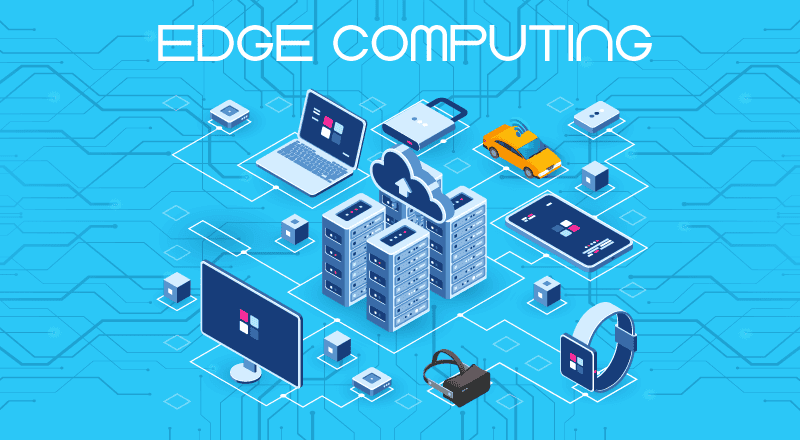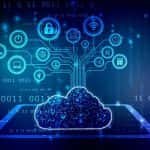World is undergoing a massive digital transformation. Technology is playing a pivotal role in this. The eminent name that most of the tech geeks often discuss is Cloud Computing. However, here we also need to mention Edge Computing. These innovative approaches have revolutionised the process we manage data.
Although, both these terms are often used in conjunction, there is a line of difference between the two. This blog highlights a comparative analysis of Edge Computing vs. Cloud Computing.
The Cloud Computing Landscape
Cloud Computing, often touted as the backbone of modern technology. It is the practice of storing and accessing data and applications over the internet. This approach eliminates the need for physical hardware and infrastructure on-site.
The businesses and individual users can use remote servers maintained by cloud service providers to store data. The flexibility and scalability offered by Cloud Computing have fueled its popularity in various domains, from enterprise-level operations to personal use.
Advantages of Cloud Computing:
Cloud Computing has transformed the way businesses and individuals approach technology by offering a range of advantages. Here are some key advantages of Cloud Computing:
1. Scalability: Cloud platforms provide a high degree of scalability. It allows the users to easily scale up or down their computing resources based on demand. This elasticity ensures efficient resource utilization and cost savings, as you only pay for what you use.
2. Cost-Efficiency: Traditional IT setups often require significant upfront investments in hardware and infrastructure. Cloud Computing shifts this cost model to a pay-as-you-go structure, where you only pay for the resources and services you consume. This reduces upfront expenses and operational costs.
3. Accessibility: Cloud services are accessible from anywhere with an internet connection. This facilitates remote work, collaboration, and the ability to access data and applications on various devices, enhancing productivity and flexibility.
4. Flexibility: Cloud Computing offers a variety of services and deployment models, such as Infrastructure as a Service (IaaS), Platform as a Service (PaaS), and Software as a Service (SaaS). This flexibility allows users to choose the level of control and management that best fits their needs.
5. Speed and Agility: Cloud services can be provisioned and deployed quickly, reducing the time it takes to set up and launch new applications. This agility is particularly valuable for businesses seeking to innovate and bring products to market faster.
6. Resource Management: Cloud providers handle the hardware and infrastructure management tasks, such as maintenance, updates, and security patches. This offloads these responsibilities from users, allowing them to focus on their core business activities.
7. Global Reach: Cloud services are typically offered through data centers located in various regions around the world. This global reach enables businesses to deliver services to a geographically diverse customer base with reduced latency.
8. Reliability and Redundancy: Cloud providers often implement redundancy and backup mechanisms to ensure high availability and data durability. This minimizes the risk of data loss and downtime.
9. Innovation: Cloud Computing encourages innovation by providing access to advanced technologies and services, such as artificial intelligence, machine learning, big data analytics, and more. Businesses can leverage these tools to gain insights, optimize processes, and create new experiences.
10. Environmental Impact: Cloud Computing can contribute to a more sustainable IT environment. By consolidating resources and optimizing server utilization in data centers, cloud providers can reduce energy consumption and minimize the carbon footprint associated with IT operations.
11. Disaster Recovery: Cloud services often come with built-in disaster recovery and backup solutions. This ensures that data is backed up and can be quickly restored in case of data loss or system failures.
12. Security: Cloud providers invest heavily in security measures to protect data and applications. They employ advanced encryption, authentication, and authorization protocols to ensure data confidentiality and integrity.
Edge Computing:
Edge Computing is a distributed computing paradigm that involves processing data closer to the source of its generation, rather than sending all data to a centralized cloud or data center for processing.
This approach aims to reduce latency, enhance real-time processing capabilities, and alleviate network congestion, making it particularly valuable for applications that require immediate responses and quick decision-making.
In traditional Cloud Computing models, data is transmitted to centralized data centers or cloud servers for processing and analysis. This can introduce delays due to the time it takes for data to travel to and from these remote locations.
Edge Computing, on the other hand, brings computational power and data storage closer to where the data is produced, often at the “edge” of the network, which could be devices, sensors, gateways, or local servers.
Advantages of Edge Computing:
Edge Computing offers a host of advantages that make it a valuable approach, especially in scenarios where real-time processing, low latency, and localized data handling are essential. Here are some key advantages of Edge Computing:
1. Low Latency: One of the most significant advantages of Edge Computing is its ability to minimize latency. By processing data locally at the edge devices or nodes, response times are drastically reduced compared to sending data to a centralized cloud server.
This is crucial for applications that demand immediate actions, such as autonomous vehicles, industrial automation, and real-time monitoring.
2. Real-Time Processing: Edge Computing enables real-time data processing and analytics at the source, allowing for instant insights and rapid decision-making. This is essential for applications that require quick reactions to changing conditions, like predictive maintenance in industrial settings.
3. Bandwidth Optimization: Edge Computing reduces the amount of data that needs to be transmitted to the cloud. By sending only relevant or summarized data, edge devices help optimize network bandwidth and decrease congestion, leading to more efficient data transfer.
4. Privacy and Security: Processing data at the edge can enhance privacy and security. Sensitive or confidential data can be processed locally, reducing the risk of exposure during transmission to the cloud. This is particularly important for industries like healthcare and finance, which handle sensitive information.
5. Offline Operation: Edge devices can continue to function even when disconnected from the central cloud infrastructure. This capability is advantageous in environments with intermittent or unreliable connectivity, ensuring uninterrupted operation.
6. Redundancy and Reliability: Edge Computing can improve system redundancy and reliability. Distributed edge nodes can continue to operate even if some nodes fail, reducing the risk of system-wide failures.
7. Scalability: Edge Computing allows for distributed scaling, where additional edge devices can be added as needed to accommodate increased demand. This flexibility is particularly useful in scenarios where data sources are dispersed.
8. Cost-Efficiency: Edge Computing can reduce costs associated with transmitting large amounts of data to the cloud, especially in cases where bandwidth costs are high or where processing data in the cloud would be resource-intensive.
9. Real-World Resource Management: In sectors like agriculture, edge devices can analyze environmental data locally to optimize irrigation, fertilization, and other resource-intensive processes, leading to more efficient resource utilization.
10. Local Data Governance: Edge Computing empowers organizations to adhere to data governance regulations by enabling them to process and store data locally, ensuring compliance with data sovereignty laws.
11. Support for IoT Growth: As the Internet of Things (IoT) continues to expand, Edge Computing is a natural fit. It supports the large-scale deployment of IoT devices by enabling local processing and filtering of data, reducing the load on centralized systems.
12. Enhanced Customer Experience: Edge Computing can enable personalized experiences in various sectors, from retail to entertainment. By processing data locally, businesses can deliver tailored content and services to customers in real time.
Edge Computing vs. Cloud Computing examples
Certainly, here are some examples that highlight the differences between Edge Computing and Cloud Computing in various real-world scenarios:
-
Autonomous Vehicles:
- Edge Computing: In autonomous vehicles, Edge Computing plays a crucial role. The sensors and cameras on the vehicle generate massive amounts of data that need to be processed in real-time to make split-second driving decisions. Edge devices within the vehicle process this data locally to ensure immediate responses and safe navigation.
- Cloud Computing: Cloud Computing comes into play when autonomous vehicles require advanced data analysis, machine learning, and updating their navigation systems. The cloud can analyze historical data from multiple vehicles to improve overall driving algorithms and deliver software updates.
-
Industrial Automation:
- Edge Computing: In a manufacturing plant, Edge Computing is used for real-time monitoring and control of machinery. Sensors attached to production equipment process data locally to detect anomalies, perform predictive maintenance, and optimize production efficiency.
- Cloud Computing: The cloud is utilized for analyzing historical performance data across multiple plants, conducting predictive analytics for future trends, and managing supply chain logistics on a larger scale.
-
Healthcare:
- Edge Computing: Wearable health devices, like fitness trackers, process users’ biometric data locally to provide real-time feedback and alerts. This immediate response is critical for scenarios where health conditions need immediate attention.
- Cloud Computing: Medical research institutions utilize the cloud to store and analyze massive datasets of patient information, contributing to the development of new treatments and personalized medicine approaches.
-
Retail:
- Edge Computing: In a retail store, edge devices process customer data locally to provide personalized recommendations and offers in real time, enhancing the shopping experience.
- Cloud Computing: The cloud is used to aggregate data from multiple retail locations, analyzing buying patterns and trends to optimize inventory management and supply chain logistics.
-
Smart Cities:
- Edge Computing: Smart streetlights equipped with sensors can adjust lighting levels based on real-time local data, such as traffic density and ambient light conditions.
- Cloud Computing: The cloud is used to centralize data from various sensors across the city to monitor overall traffic patterns, energy consumption, and to implement predictive maintenance for infrastructure.
-
Energy Management:
- Edge Computing: In a residential smart energy system, edge devices within homes process real-time data from appliances and solar panels to optimize energy consumption and storage locally.
- Cloud Computing: Energy companies analyze aggregated data from numerous households to optimize energy distribution across the grid, manage demand peaks, and plan future infrastructure improvements.
Tabular Representation of Difference Between Edge Computing and Cloud Computing:
Certainly, here’s a tabular representation outlining the key differences between Edge Computing and Cloud Computing:
| Aspect | Edge Computing | Cloud Computing |
| Location | Processing occurs at or near data source | Processing occurs in centralized data centers |
| Latency | Low latency due to local processing | Higher latency due to data transmission |
| Data Processing | Real-time processing for immediate decisions | Extensive data analysis and batch processing |
| Scalability | Scalability limited by device capabilities | High scalability with cloud resources |
| Bandwidth Usage | Minimizes network bandwidth through local processing | Data transmitted to/from central servers |
| Data Privacy | Enhanced privacy by keeping sensitive data locally | Data transmission raises privacy concerns |
| Offline Operation | Operates even without continuous internet connectivity | Relies on constant internet connection |
| Redundancy | Limited redundancy; failure impacts local area | Cloud providers offer redundancy mechanisms |
| Resource Ownership | Devices are owned by individual users or organizations | Cloud infrastructure is managed by providers |
| Use Cases | Real-time analytics, IoT, autonomous vehicles | Big data analytics, machine learning, SaaS |
| Maintenance | Local maintenance and updates for edge devices | Cloud providers handle maintenance and updates |
| Initial Cost | Potentially higher initial device setup cost | Lower initial cost due to pay-as-you-go model |
| Flexibility | May offer limited flexibility compared to cloud services | Offers a wide range of services and models |
| Centralization | Distributed processing with local decision-making | Centralized processing and management |
| Examples | Autonomous vehicles, IoT devices, industrial automation | Web applications, data analytics, virtualization |
Challenges of Edge Computing:
1. Limited Resources: Edge devices often have limited computational power, memory, and storage, which can restrict the complexity of applications they can run.
2. Data Security: Distributing data across edge devices increases the attack surface, making it more challenging to implement robust security measures.
3. Management Complexity: Managing a large number of edge devices spread across different locations can become complex and resource-intensive.
4. Latency Variability: The performance of edge devices can vary based on factors like network conditions and device capabilities, impacting the consistency of real-time processing.
5. Scalability: Scaling edge infrastructure to accommodate growing demands can be challenging due to the need for physical deployment and resource limitations.
6. Data Synchronization: Ensuring data consistency across multiple edge devices and the cloud can be complex, especially in dynamic and distributed environments.
Challenges of Cloud Computing:
1. Latency: Cloud Computing can introduce latency due to the need to transmit data to remote data centers for processing, affecting real-time applications.
2. Data Privacy and Compliance: Storing sensitive data in the cloud raises privacy and compliance concerns, especially with regulations like GDPR.
3. Vendor Lock-In: Cloud providers often use proprietary technologies, leading to potential vendor lock-in, making it difficult to switch providers.
4. Downtime and Outages: Dependence on a single cloud provider can expose businesses to downtime risks if the provider experiences outages.
5. Data Transfer Costs: Large-scale data transfer between on-premises infrastructure and the cloud can result in unexpected costs.
6. Security Concerns: Although cloud providers implement strong security measures, data breaches and vulnerabilities can still occur.
Future of Edge Computing and Cloud Computing:
Edge Computing:
The future of Edge Computing will likely involve improved device capabilities, better integration with AI and machine learning, and enhanced security measures. As IoT adoption grows, edge devices will become more powerful and capable, enabling sophisticated local processing. Edge Computing will play a critical role in enabling applications like autonomous vehicles, smart cities, and real-time healthcare monitoring.
Cloud Computing:
Cloud Computing will continue to evolve with advancements in AI, machine learning, and big data analytics. Hybrid cloud models, which combine public and private clouds, will gain prominence, providing greater flexibility and control.
Conclusion
Edge Computing and Cloud Computing represent two essential paradigms that address distinct challenges in the world of data processing and storage. While Edge Computing provides low latency and real-time processing advantages, Cloud Computing offers extensive resources, scalability, and centralized management.
The future will likely see the convergence of these two paradigms, enabling organizations to leverage the strengths of both approaches for optimal performance and efficiency. As technology continues to advance, a balanced integration of edge and Cloud Computing will drive innovation and shape the digital landscape.













